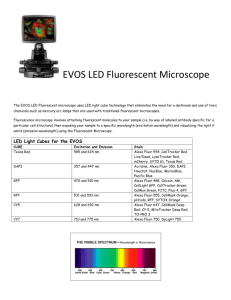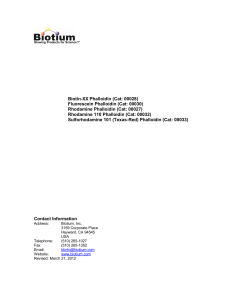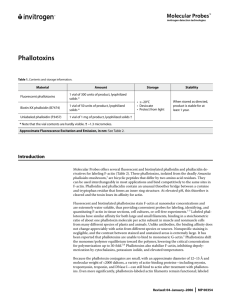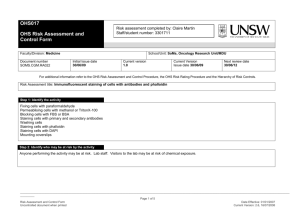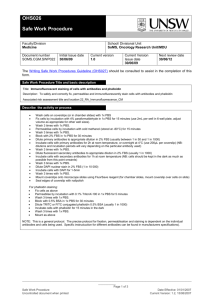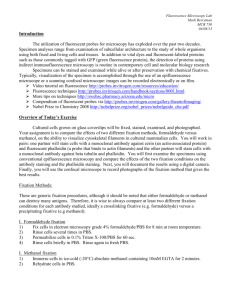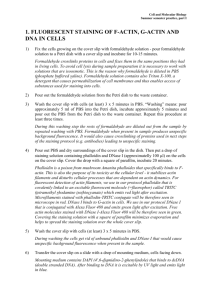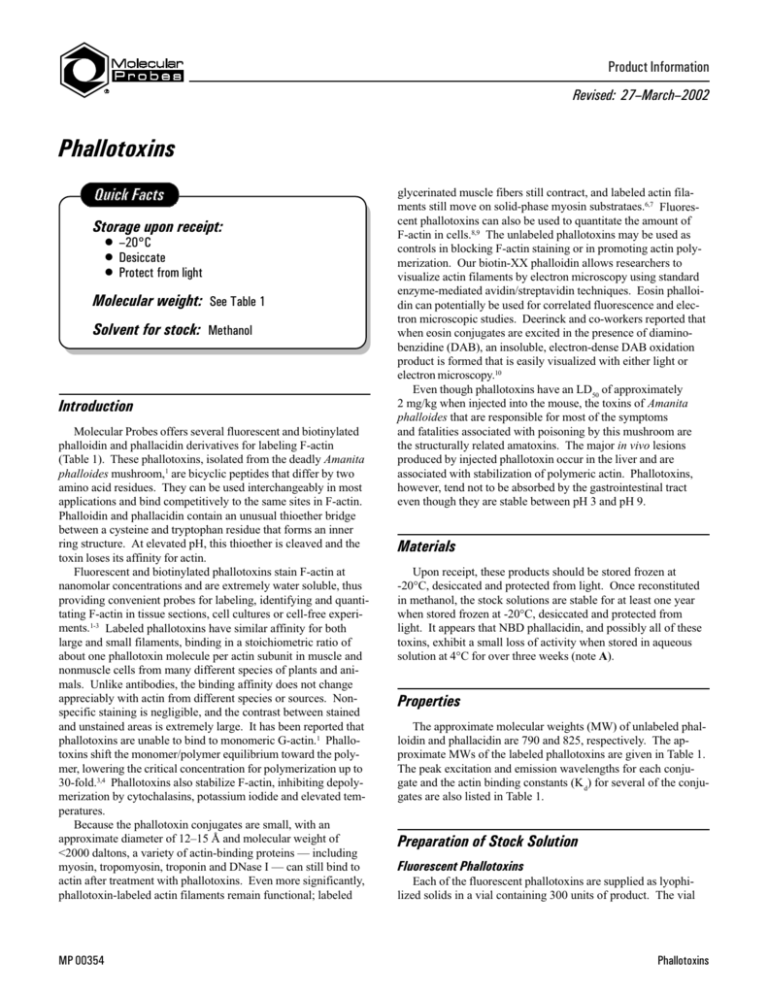
Product Information
Revised: 27March2002
Phallotoxins
Storage upon receipt:
20°C
Desiccate
Protect from light
Molecular weight: See Table 1
Solvent for stock: Methanol
Introduction
Molecular Probes offers several fluorescent and biotinylated
phalloidin and phallacidin derivatives for labeling F-actin
(Table 1). These phallotoxins, isolated from the deadly Amanita
phalloides mushroom,1 are bicyclic peptides that differ by two
amino acid residues. They can be used interchangeably in most
applications and bind competitively to the same sites in F-actin.
Phalloidin and phallacidin contain an unusual thioether bridge
between a cysteine and tryptophan residue that forms an inner
ring structure. At elevated pH, this thioether is cleaved and the
toxin loses its affinity for actin.
Fluorescent and biotinylated phallotoxins stain F-actin at
nanomolar concentrations and are extremely water soluble, thus
providing convenient probes for labeling, identifying and quantitating F-actin in tissue sections, cell cultures or cell-free experiments.1-3 Labeled phallotoxins have similar affinity for both
large and small filaments, binding in a stoichiometric ratio of
about one phallotoxin molecule per actin subunit in muscle and
nonmuscle cells from many different species of plants and animals. Unlike antibodies, the binding affinity does not change
appreciably with actin from different species or sources. Nonspecific staining is negligible, and the contrast between stained
and unstained areas is extremely large. It has been reported that
phallotoxins are unable to bind to monomeric G-actin.1 Phallotoxins shift the monomer/polymer equilibrium toward the polymer, lowering the critical concentration for polymerization up to
30-fold.3,4 Phallotoxins also stabilize F-actin, inhibiting depolymerization by cytochalasins, potassium iodide and elevated temperatures.
Because the phallotoxin conjugates are small, with an
approximate diameter of 1215 Å and molecular weight of
<2000 daltons, a variety of actin-binding proteins including
myosin, tropomyosin, troponin and DNase I can still bind to
actin after treatment with phallotoxins. Even more significantly,
phallotoxin-labeled actin filaments remain functional; labeled
MP 00354
glycerinated muscle fibers still contract, and labeled actin filaments still move on solid-phase myosin substrataes.6,7 Fluorescent phallotoxins can also be used to quantitate the amount of
F-actin in cells.8,9 The unlabeled phallotoxins may be used as
controls in blocking F-actin staining or in promoting actin polymerization. Our biotin-XX phalloidin allows researchers to
visualize actin filaments by electron microscopy using standard
enzyme-mediated avidin/streptavidin techniques. Eosin phalloidin can potentially be used for correlated fluorescence and electron microscopic studies. Deerinck and co-workers reported that
when eosin conjugates are excited in the presence of diaminobenzidine (DAB), an insoluble, electron-dense DAB oxidation
product is formed that is easily visualized with either light or
electron microscopy.10
Even though phallotoxins have an LD50 of approximately
2 mg/kg when injected into the mouse, the toxins of Amanita
phalloides that are responsible for most of the symptoms
and fatalities associated with poisoning by this mushroom are
the structurally related amatoxins. The major in vivo lesions
produced by injected phallotoxin occur in the liver and are
associated with stabilization of polymeric actin. Phallotoxins,
however, tend not to be absorbed by the gastrointestinal tract
even though they are stable between pH 3 and pH 9.
Materials
Upon receipt, these products should be stored frozen at
-20°C, desiccated and protected from light. Once reconstituted
in methanol, the stock solutions are stable for at least one year
when stored frozen at -20°C, desiccated and protected from
light. It appears that NBD phallacidin, and possibly all of these
toxins, exhibit a small loss of activity when stored in aqueous
solution at 4°C for over three weeks (note A).
Properties
The approximate molecular weights (MW) of unlabeled phalloidin and phallacidin are 790 and 825, respectively. The approximate MWs of the labeled phallotoxins are given in Table 1.
The peak excitation and emission wavelengths for each conjugate and the actin binding constants (K d) for several of the conjugates are also listed in Table 1.
Preparation of Stock Solution
Fluorescent Phallotoxins
Each of the fluorescent phallotoxins are supplied as lyophilized solids in a vial containing 300 units of product. The vial
Phallotoxins
Table 1. Spectral characteristics and dissociation constants of phallotoxin probes.
Cat #
Conjugate
Ex (nm) *
Em (nm) *
Approximate
MW
Kd (nM)
A-22281
Alexa Fluor 350 phalloidin
346
442
1100
ND
C-606
coumarin phallacidin
355
443
1100
24
N-354
NBD phallacidin
465
536
1040
18
A-12379
Alexa Fluor 488 phalloidin
495
518
1320
ND
F-432
fluorescein phalloidin
496
516
1175
18
O-7466
Oregon Green 488 phalloidin
496
520
1180
ND
B-607
BODIPY FL phallacidin
505
512
1125
38
O-7465
Oregon Green 514 phalloidin
511
528
1281
ND
E-7463
eosin phalloidin
524
544
1500
ND
A-22282
Alexa Fluor 532 phalloidin
531
554
1350
ND
R-415
rhodamine phalloidin
554
573
1250
40
A-22283
Alexa Fluor 546 phalloidin
556
573
1800
ND
B-3475
BODIPY 558/568 phalloidin
558
569
1115
ND
A-12380
Alexa Fluor 568 phalloidin
578
600
1590
ND
A-12381
Alexa Fluor 594 phalloidin
581
609
1620
ND
B-3416
BODIPY 581/591 phalloidin
584
592
1150
ND
B-7464
BODIPY TR-X phallacidin
589
617
1400
ND
T-7471
Texas Red-X phalloidin
591
608
1490
ND
A-22284
Alexa Fluor 633 phalloidin
632
647
1900
ND
B-12382
BODIPY 650/665 phalloidin
647
661
1200
ND
A-22287
Alexa Fluor 647 phalloidin
650
668
1950
ND
A-22285
Alexa Fluor 660 phalloidin
663
690
1750
ND
A-22286
Alexa Fluor 680 phalloidin
679
702
1850
ND
B-7474
biotin-XX phalloidin
NA
NA
1300
10.5
* Approximate absorption (Abs) and fluorescence emission maxima in nm. Complete spectra for most of these dyes are available at our Web site
(www.probes.com). Rhodamine phalloidins fluorescence increases upon binding to actin, a phenomenon that allowed Molecular Pr
obes researchers to
10
determine the ligands binding constant. The binding constants of the other conjugates were determined by competitive binding with rhodamine phalloidin.
All binding constants were determined on rabbit skeletal muscle actin. ND = not determined. NA = not applicable.
For biotin-XX phalloidin, 10 µL of the methanolic stock solution is equivalent to one unit of phallotoxin, which is defined as
the amount of material used to stain one microscope slide of
fixed cells according to the following protocol (see step 1.6).
contents (which are hardly visible) should be dissolved in 1.5 mL
methanol to yield a final concentration of 200 units/mL, which is
equivalent to approximately 6.6 µM.
One unit of phallotoxin is defined as the amount of material
used to stain one microscope slide of fixed cells, according to the
following protocol (see step 1.6), and is equivalent to 5 µL of
methanolic stock solution for the fluorescent phallotoxins.
Unlabeled Phalloidin
Unlabeled phalloidin (P-3457) is supplied as lyophilized
solid in a vial containing 1 mg of product (approximately
1.3 µmole). Solutions of this product should be prepared just
like the fluorescent phallotoxins described in Fluorescent
Phallotoxins, taking into account the larger quantity of material
provided.
Biotin-XX Phalloidin
Staining cells with biotin-XX phalloidin (B-7474) requires
1) the use of a higher concentration of the phallotoxin conjugate
than when staining with fluorescent phallotoxins and 2) the addition of a fluorescent or enzyme-conjugated avidin or streptavidin
detection reagent (see step 1.9). Biotin-XX phalloidin is supplied as a lyophilized solid in a vial containing 50 units of product. The vial contents (which are hardly visible) should be
dissolved in 0.5 mL methanol to yield a final concentration of
100 units/mL, which is equivalent to approximately 20 µM.
Procedures for Staining Slides
The procedure below was originally developed for use with
NBD phallacidin.11 It has been successfully used with all of
2
Phallotoxins
Molecular Probes phallotoxin conjugates. This procedure may
not be optimum for a particular experimental system, but has
yielded consistent results in most instances. The following protocol describes the staining procedure for adherent cells grown
on glass coverslips.
2.1 Prepare a 1 mL solution containing 50 to 100 µg/mL lysopalmitoylphosphatidylcholine and 3.7% formaldehyde and then
add 510 units of fluorescent phallotoxin (approximately 25 to
50 µL of methanolic stock solution).
2.2 Place this staining solution on cells and incubate for 20 minutes at 4°C.
Formaldehyde-Fixed Cells
1.1 Wash cells twice with prewarmed phosphate-buffered saline,
pH 7.4 (PBS).
2.3 Rapidly wash three times with buffer.
2.4 Mount coverslips and view.
1.2 Fix the sample in 3.7% formaldehyde solution in PBS for
10 minutes at room temperature (note B).
Living Cells
1.3 Wash two or more times with PBS.
Phallotoxins are usually not cell-permeant and have therefore
not been used extensively with living cells. However, living cells
have been labeled.11,12 Pinocytosis appears to be the method of
entry for some cells, although hepatocytes avidly take up the
dye by an unknown mechanism.5,13 In general, a larger amount
of stain will be needed for staining living cells. Rhodamine
phalloidin has been microinjected into fibroblasts without noticeable changes in shape or ruffling.14,15 Injections of phalloidin
into living cells appear to alter the actin distribution and cell motility.16,17 Consult the literature to find procedures suitable for
your experiments.
1.4 Place each coverslip in a glass petri dish and extract it with
a solution of acetone at -20°C or 0.1% Triton® X-100 in PBS for
3 to 5 minutes.
1.5 Wash two or more times with PBS.
1.6 When staining with any of the fluorescent phallotoxins, dilute 5 µL methanolic stock solution into 200 µL PBS for each
coverslip to be stained. To reduce nonspecific background staining with these conjugates, add 1% bovine serum albumin (BSA)
to the staining solution. It may also be useful to pre-incubate
fixed cells with PBS containing 1% BSA for 2030 minutes
prior to adding the phallotoxin staining solution.
When staining with biotin-XX phalloidin (B-7474), dilute
10 µL of the methanolic stock solution into 200 µL PBS for each
coverslip to be stained.
When staining more than one coverslip, adjust volumes accordingly. For a stronger signal, use 2 or 3 units per coverslip.
Fluorescence Microscopy
Photostability or resistance to photobleaching is a primary
concern when making fluorescence measurements. Alexa Fluor®,
Oregon Green®, BODIPY® and rhodamine fluorophores (including Texas Red®-X) are significantly more photostable than NBD
and fluorescein and will therefore enable more accurate photographic measurements. To further reduce photobleaching, minimize the exposure of fluorescently labeled specimens to light
with neutral density filters and expose samples only when observing or recording a signal. Maximize collection of fluorescence by using a minimum of optics, highBnumerical aperture
objectives, relatively low magnification, high-quality optical filters and high-speed film or high-efficiency detectors. Antifade
reagents, including Molecular Probes SlowFade®, SlowFade®
Light and ProLong® Antifade Kits (S-2828, S-7461, P-7481),
can extend the useful lives of many fluorescent probes.18 These
antifade solutions can be used on fixed cell preparations but are
not compatible with living cells. Cytoseal also appears to protect BODIPY fluorophores from photobleaching.
1.7 Place the staining solution on the coverslip for 20 minutes at
room temperature (generally, any temperature between 4°C and
37°C is suitable). To avoid evaporation, keep the coverslips inside a covered container during the incubation.
1.8 Wash two or more times with PBS.
1.9 When using biotin-XX phalloidin, incubate for 30 minutes
with 100 µL of a 10 µg/mL solution of fluorescent or enzymeconjugated streptavidin dissolved in 100 mM Tris-HCl, pH 7.5,
150 mM NaCl, 0.3% Triton X-100 and 1% BSA. Incubate for
15 minutes at room temperature. After incubation, wash the coverslip with PBS. To develop enzyme activity, follow a procedure
recommended for the specific enzyme.
Notes
1.10 Mount the coverslip on a slide with the cell-side down in a
1:1 solution of PBS and glycerol and seal the edges of the coverslip. Specimens prepared in this manner retain actin staining for
at least 2B3 days when stored in the dark at 4°C. For long-term
storage, the cells should be air dried and then mounted in an
acrylic-based resin such as Cytoseal. Specimens prepared in
this manner retain actin staining for at least six months when
stored in the dark at 4°C.
[A] While the amount of toxin present in a vial could be lethal
only to a mosquito (LD50 of phalloidin = 2 mg/kg), it should be
handled with care.
[B] Methanol can disrupt actin during the fixation process.
Therefore, it is best to avoid any methanol containing fixatives.
The preferred fixative is methanol-free formaldehyde.
Simultaneous Fixation, Permeabilization and Fluorescent
Phallotoxin Staining
The phallotoxins appear to be stable for short periods in 4%
formaldehyde fixation buffers. This permits a rapid one-step
fixation, permeabilization and labeling procedure as follows.
3
Phallotoxins
References
1. Wieland, T. in Phallotoxins, Springer-Verlag, New York (1986); 2. J Muscle Res Cell Motil 9, 370 (1988); 3. Methods Enzymol 85, 514 (1982); 4. Eur J
Biochem 165, 125 (1987); 5. J Cell Biol 105, 1473 (1987); 6. Nature 326, 805 (1987); 7. Proc Natl Acad Sci USA 83, 6272 (1986); 8. Blood 69, 945 (1987);
9. Anal Biochem 200, 199 (1992); 10. J Cell Biol 126, 901 (1994); 11. Proc Natl Acad Sci USA 77, 980 (1980); 12. Nature 284, 405 (1980); 13. CRC Crit
Rev Biochem 5, 185 (1978); 14. J Cell Biol 106, 1229 (1988); 15. J Cell Biol 103, 265a (1986); 16. Eur J Cell Biol 24, 176 (1981); 17. Proc Natl Acad Sci
USA 74, 5613 (1977); 18. Science 217, 1252 (1982); 19. J Histochem Cytochem 42, 345 (1994); 20. Biotech Histochem 68, 8 (1993); 21. J Histochem
Cytochem 40, 1605 (1992); 22. J Biol Chem 269, 14869 (1994).
Product List
Current prices may be obtained from our Web site or from our Customer Service Department.
Cat #
Product Name
Unit Size
A-22281
A-12379
A-22282
A-22283
A-12380
A-12381
A-22284
A-22287
A-22285
A-22286
B-7474
B-3475
B-3416
B-12382
B-607
B-7464
C-606
E-7463
F-432
N-354
O-7466
O-7465
P-3457
R-415
T-7471
Alexa Fluor® 350 phalloidin ......................................................................................................................................................
Alexa Fluor® 488 phalloidin ......................................................................................................................................................
Alexa Fluor® 532 phalloidin ......................................................................................................................................................
Alexa Fluor® 546 phalloidin ......................................................................................................................................................
Alexa Fluor® 568 phalloidin ......................................................................................................................................................
Alexa Fluor® 594 phalloidin ........................................................................................................................................................
Alexa Fluor® 633 phalloidin ........................................................................................................................................................
Alexa Fluor® 647 phalloidin ........................................................................................................................................................
Alexa Fluor® 660 phalloidin ........................................................................................................................................................
Alexa Fluor® 680 phalloidin ........................................................................................................................................................
biotin-XX phalloidin ....................................................................................................................................................................
BODIPY® 558/568 phalloidin .....................................................................................................................................................
BODIPY® 581/591 phalloidin .....................................................................................................................................................
BODIPY® 650/665 phalloidin .....................................................................................................................................................
BODIPY® FL phallacidin ............................................................................................................................................................
BODIPY® TR-X phallacidin ........................................................................................................................................................
coumarin phallacidin ..................................................................................................................................................................
eosin phalloidin ..........................................................................................................................................................................
fluorescein phalloidin .................................................................................................................................................................
N-(7-nitrobenz-2-oxa-1,3-diazol-4-yl)phallacidin (NBD phallacidin) ...........................................................................................
Oregon Green® 488 phalloidin ...................................................................................................................................................
Oregon Green® 514 phalloidin ...................................................................................................................................................
phalloidin ...................................................................................................................................................................................
rhodamine phalloidin ..................................................................................................................................................................
Texas Red®-X phalloidin ............................................................................................................................................................
4
300 U
300 U
300 U
300 U
300 U
300 U
300 U
300 U
300 U
300 U
50 U
300 U
300 U
300 U
300 U
300 U
300 U
300 U
300 U
300 U
300 U
300 U
1 mg
300 U
300 U
Phallotoxins
Contact Information
Further information on Molecular Probes' products, including product bibliographies, is available from your local distributor or directly from Molecular
Probes. Customers in Europe, Africa and the Middle East should contact our office in Leiden, the Netherlands. All others should contact our Technical Assistance Department in Eugene, Oregon.
Please visit our Web site www.probes.com for the most up-to-date information
Molecular Probes, Inc.
PO Box 22010, Eugene, OR 97402-0469
Phone: (541) 465-8300 Fax: (541) 344-6504
Molecular Probes Europe BV
PoortGebouw, Rijnsburgerweg 10
2333 AA Leiden, The Netherlands
Phone: +31-71-5233378 Fax: +31-71-5233419
Customer Service: 7:00 am to 5:00 pm (Pacific Time)
Phone: (541) 465-8338 Fax: (541) 344-6504 order@probes.com
Customer Service: 9:00 to 16:30 (Central European Time)
Phone: +31-71-5236850 Fax: +31-71-5233419
eurorder@probes.nl
Toll-Free Ordering for USA and Canada:
Order Phone: (800) 438-2209 Order Fax: (800) 438-0228
Technical Assistance: 9:00 to 16:30 (Central European Time)
Phone: +31-71-5233431 Fax: +31-71-5241883
eurotech@probes.nl
Technical Assistance: 8:00 am to 4:00 pm (Pacific Time)
Phone: (541) 465-8353 Fax: (541) 465-4593 tech@probes.com
Molecular Probes products are high-quality reagents and materials intended for research purposes only. These products must be used by, or directly
under the supervision of, a technically qualified individual experienced in handling potentially hazardous chemicals. Please read the Material Safety Data Sheet
provided for each product; other regulatory considerations may apply.
Several of Molecular Probes products and product applications are covered by U.S. and foreign patents and patents pending. Our products are not
available for resale or other commercial uses without a specific agreement from Molecular Probes, Inc. We welcome inquiries about licensing the use of our
dyes, trademarks or technologies. Please submit inquiries by e-mail to busdev@probes.com. All names containing the designation ® are registered with the
U.S. Patent and Trademark Office.
Copyright 2002, Molecular Probes, Inc. All rights reserved. This information is subject to change without notice.
5
Phallotoxins

